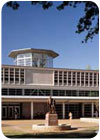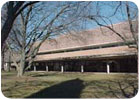
A renovation of the John M. Olin Library on the campus of Washington University in St. Louis, MO, involved removing portions of Missouri Red granite to allow light to penetrate the building.
In updating the design of the John M. Olin Library on the campus of Washington University in St. Louis, MO, the design team reworked the existing Missouri Red granite facade to allow more light into the building
While the John M. Olin Library at Washington University in St. Louis, MO, was the sixth building project that Kallmann McKinnell & Wood Architects had completed on campus, the firm's approach to the renovation and expansion of the building was very different from anything that they had previously designed. With solid granite walls comprising the exterior of the structure's east and west sides, the library was a dark and uninviting space for students to study. As a result, the project involved reworking the exterior stone to make it more visually stimulating and to bring natural light inside.
“It was a state-of-the-art library in the early '60s, but it was about book storage,†said Project Architect Rayford Law, AIA, a principal at Kallmann McKinnell & Wood in Boston, MA. “As a library, it wasn't a place to go and do research, so we pulled some material off to bring light into it. Part of the design was the manipulation of stone - taking some of it away. We've made it a place where people can connect back to the campus.â€

In addition to Missouri Red granite, the exterior of the library features Buff Indiana limestone trim pieces.
“The appropriateness of stone has to do with the careful measurement of how much stone one needs,†said Law. “Here was the careful deployment of the removal of some stone and the cleaning of some stone.†The architect went on to explain that the renovation was about eliminating some of the opaque material to let light into the building; it was not to be critical of the material or the original intentions of the architect who designed it.
In reworking the exterior granite facade, the design team replaced the solid stone walls on the east and west sides of the top floor with a sun-screened curtainwall. The amount of windows on the floor below was also increased.

“It was a state-of-the-art library in the early '60s, but it was about book storage,†said Project Architect Rayford Law, AIA, a principal at Kallmann McKinnell & Wood in Boston, MA, when speaking about the building's architecture before the renovation (pre-renovation building pictured). “We've made it a place where people can connect back to the campus.â€
“There was a deep arcade - about 14 feet deep - that was always wet and dripping down through the concrete,†said Law. “We pushed the enclosure out, and made that space at the perimeter. We made a transparent wall with some limestone trim. The idea is that you want to see people and to be seen as well.â€
As part of the complete re-configuration of the ground floor, the entrance was moved from the east side to the south side of the building. This allowed for better control of access into the building and a common entry vestibule for the cyber-café and library. It also provided for the consolidation of the various user services in a single shared services/checkout desk.
Moreover, reading and work areas were relocated to the ground floor to provide more space on the upper level for the Special Collections, including rare and archival materials. Additionally, the book storage was moved to the lowest stack floor. This entire stack floor was converted to compact shelving to utilize the space more efficiently.
“What was nice about this building was that it involved careful coordination of a lot of building trades - the sum of which all across the board made this a very successful building,†said Law. “The issue was to keep it operational at all times.†In total, it took almost three years to complete the renovation and expansion at the John M. Olin Library.
